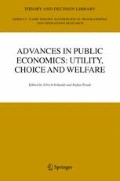6. Conclusion
We have presented equivalence scales derived from a survey where subjects have been asked to assess the income needs of different hypothetical households given five levels of reference income of a reference household. We find that equivalence scales obtained negatively depend on the level of reference income. This finding strongly questions the results of previous studies where equivalence scales have been assumed to be constant. Obviously, this constancy assumption either means an overestimation of the needs of “rich” or the underestimation of the needs of “poor” multi-person households or the mis-specification of the needs of both. Second, the number of adults in the household turns out to be an important criterion for the evaluation of children needs. According to our respondents, the income needs of children are an increasing function of the number of adult household members. It is, therefore, necessary to broaden economic models with respect to this interaction.
Access this chapter
Tax calculation will be finalised at checkout
Purchases are for personal use only
Preview
Unable to display preview. Download preview PDF.
References
Aaberge, R., and I. Melby 1998. “The Sensitivity of Income Inequality to Choice of Equivalence Scales,” Review of Income and Wealth 44, 565–569.
Atkinson, A. B. 1983. The Economics of Inequality, Oxford.
Blackorby, C., and D. Donaldson 1988. “Adult-Equivalence Scales and the Economic Implementation of Interpersonal Comparisons of Well-Being,” University of British Columbia, Discussion Paper No. 88-27.
Caplovitz, D. 1967. it The Poor Pay More, New York: The Free Press.
Conniffe, D. 1992. “The Non-Constancy of Equivalence Scales,” Review of Income and Wealth 38, 429–443.
Coulter, F. A. E., F. A. Cowell, and S. P. Jenkins 1992. “Differences in Needs and Assessment of Income Distributions,” Bulletin of Economic Research 44, 77–124.
Dickens, R., V. Fry, and P. Pashardes 1993. “Non-Linearities and Equivalence Scales,” The Economic Journal 103, 359–368.
Donaldson, D., and K. Pendakur 2004. “Equivalent-expenditure Functions and Expenditure-dependent Equivalence Scales,” Journal of Public Economics 88, 175–208.
Dubnoff, S. 1985. “How much Income is Enough? Measuring Public Judgements,” Public Opinion Quarterly 49, 285–299.
Faik, J. 1995. Äquivalenzskalen, Theoretische Erörterungen, empirische Ermittlung und verteilungsbezogene Anwendung für die Bundesrepublik Deutschland, Berlin: Duncker and Humblot.
Friedman, R. D. 1965. Poverty, Definition and Perspective, Washington D. C: American Enterprise Institute.
Goedhart, T., V. Halberstadt, A. Kapteyn, and B. M. S. van Praag 1977. “The Poverty Line. Concept and Measurement,” Journal of Human Resources 12, 503–520.
Hartog, J. 1988. “Poverty and the Measurement of Individual Welfare. A Review of A. J. M. Hagenaars’ The Persception of Poverty,” Journal of Human Resources 23, 243–266.
Kapteyn, A., S. van de Geer, and H. van de Stadt 1984. The Impact of Changes in Income and Family Composition on Subjective Measures of Well-Being, Netherlands Central Bureau of Statistics, Department for Statistics of Income and Consumption, Voorburg.
Kapteyn, A., and B. M. S. van Praag 1976. “A New Approach to the Construction of Family Equivalence Scales,” European Economic Review 7, 313–335.
Klein, T. 1994. “Einkommen und Bedarf im Haushaltszusammenhang-Äquivalenzskalen als Instrument der Wohlfahrtsmessung,” in: Hauser, R., N. Ott, and G. Wagner (eds.), Mikroanalytische Grundlagen der Gesellschaftspolitik, vol. 2, Berlin: Akademie-Verlag, 278–294.
Klein, T. 1986. Aquivalenzskalen-Ein Literatursurvey, SfB 3-working paper 195, Frankfurt am Main and Mannheim.
Koulovatianos, C., C. Schröder, and U. Schmidt 2005. “On the Income Dependence of Equivalence Scales,” Journal of Publics Economics forthcoming.
Lancaster, G., and R. Ray 1998. “Comparison of Alternative Models of Household Equivalence Scales: The Australian Evidence on Unit Record Data,” The Economic Record 74, 1–14.
Lewbel, A. 1989. “Household Equivalence Scales and Welfare Comparisons,” Journal of Public Economics 39, 377–391.
Merz, J., and J. Faik 1995. “Equivalence Scales Based on Revealed Preference Consumption Expenditures, The Case of Germany,” Jahrbücher für Nationalökonomie und Statistik 214, 425–447.
Missong, M., and I. Stryck 1998. “Lineare Ausgabensysteme, Existenzminima und Sozialhilfe,” Jahrbücher für Nationalökonomie und Statistik 217, 574–587.
Nelson, J. A. 1993. “Independent of Base Equivalence Scales Estimation Using United States Micro-Level Data,” Annales DEconomie et de Statistique 29, 43–63.
Piachaud, D. 1974. Do the Poor Pay More?, London: Child Poverty Action Group.
Rainwater, L. (1974), What Money Buys: Inequality and the Social Meanings of Income, New York.
Rein, M. 1974. “Problems in the Definition and Measurement of Poverty,” in: Townsend, P. (ed.), The Concept of Poverty, London: Heinemann, 46–63.
Seidl, C. 1994. “How Sensible is the Leyden Individual Welfare Function of Income,” European Economic Review 38, 1633–1659.
Seneca, J. J., and M. K. Taussig 1971. “Family Equivalence Scales and Personal Income Tax Exemptions for Children,” The Review of Economics and Statistics 53, 253–262.
Stolz, I. 1983. Einkommensumverteilung in der Bundesrepublik Deutschland, Eine theoretische und empirische Untersuchung, Frankfurt am Main and New York: Campus Verlag.
Townsend, P. 1962. “The Meaning of Poverty,” British Journal of Sociology 13, 210–227.
Van der Gaag, J., and E. Smolensky 1982. “True Household Equivalence Scales and Characteristics of the Poor in the United States,” The Review of Income and Wealth 28, 17–28.
Van Hoa, T. 1986. “Measuring Equivalence Scales: A New System-Wide Method,” Economics Letters 20, 95–99.
Author information
Authors and Affiliations
Editor information
Editors and Affiliations
Rights and permissions
Copyright information
© 2005 Springer
About this chapter
Cite this chapter
Schröder, C., Schmidt, U. (2005). A New Subjective Approach to Equivalence Scales: An Empirical Investigation. In: Schmidt, U., Traub, S. (eds) Advances in Public Economics: Utility, Choice and Welfare. Theory and Decision Library C:, vol 38. Springer, Boston, MA. https://doi.org/10.1007/0-387-25706-3_8
Download citation
DOI: https://doi.org/10.1007/0-387-25706-3_8
Publisher Name: Springer, Boston, MA
Print ISBN: 978-0-387-25705-1
Online ISBN: 978-0-387-25706-8
eBook Packages: Business and EconomicsEconomics and Finance (R0)

